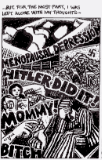Trauma is the Perfect Crime
The Holocaust was a brutal and systematic attempt to annihilate the Jewish people, resulting in extreme physical suffering, and loss of life. However, the psychological trauma inflicted on survivors is equally, if not more devastating. In "Maus", Art Spiegelman tells the story of his father, Vladek, a Holocaust survivor who struggles with trauma and horrors in the war. But perhaps one of the most important and unique part of "Maus" is when Spiegelman includes his "Prisoner on the Hell Planet" comic, where the art, style, and tone completely stands out from the rest of the book to present the ultimate conflict and theme of trauma of his mother's death.
Additionally, the art style and background further increase in detail to add to the effect of Spiegelman's trauma. The book already clued in on specific motifs such as stripes that represent the war and bars that represent the cells, but this is significantly emphasized in this portion where it almost becomes impossible to unnotice. It becomes evident that Spiegelman tries to illustrate that he feels like a prisoner mentally with the striped clothing he wears and the prison panels where he is locked in a physical jail. Furthermore, the hypnotizing background symbolizes that he feel stuck, just like a hypnotized person would in a trance. These elements further highlight his guilt he feels for his attitude toward his mother and is significantly more effective presenting the theme of trauma than the animal depictions.
By utilizing a different art style, and tone, Spiegelman underscores the unique and profound nature of trauma that he experienced. "Prisoner on the Hell Planet" becomes a testament to the long-lasting effects of trauma, breaking away from the metaphorical approach of the rest of "Maus" to deliver a sharp exploration of the human experience.
The first notable shift is from the metaphoric representation of characters as animals to a more realistic approach by using human faces. Spiegelman used animals to represent different races, ethnicities, and parties in the book to illustrate the context and drive the momentum of the plot. However, the illustrations are brief and faint, which is why once the reader understands the context and history, Spiegelman employs a more expressionistic and emotionally charged approach, with detail and lifelike drawings of humans. However, what truly makes the humans resonate is the sharp and almost terrifying faces. Vladek's face almost looks like a skeleton head, which represents that he is still alive but feels dead inside anyway. The reactions of the characters are also emphasized - The doctors almost look villain-like, because of the deep emotional trauma the doctors inflicted on Artie when they said "She's dead! A Suicide". The detail and exaggeration of the human faces essentially removes the buffer of metaphors and symbolism of animals which reveals Spiegelman's true feelings of trauma.
Additionally, the art style and background further increase in detail to add to the effect of Spiegelman's trauma. The book already clued in on specific motifs such as stripes that represent the war and bars that represent the cells, but this is significantly emphasized in this portion where it almost becomes impossible to unnotice. It becomes evident that Spiegelman tries to illustrate that he feels like a prisoner mentally with the striped clothing he wears and the prison panels where he is locked in a physical jail. Furthermore, the hypnotizing background symbolizes that he feel stuck, just like a hypnotized person would in a trance. These elements further highlight his guilt he feels for his attitude toward his mother and is significantly more effective presenting the theme of trauma than the animal depictions.
The tone also shifts dramatically, the emotional weight becoming heavier as Artie grapples with the suicide of his mother. The rawness of the emotions is laid bare, and the text becomes more confessional, nostalgic, and deep. Spiegelman reveals that he struggles with his thoughts on his mother's death, especially the causes. He has flashbacks of his mother and includes quotations like "Mommy!" and "Hitler did it!" which reveals his many attitudes toward his mother's death. One effect he most likely feels is guilt because he previously has a memory of showing love and care while reading together, while it contrasts with the present Artie in the panel holding his head with his hands. Alternatively, Spiegelman could feel anger toward Hitler, because ultimately, he is the cause for Anja's menopausal depression by killing her family and close relatives.
By utilizing a different art style, and tone, Spiegelman underscores the unique and profound nature of trauma that he experienced. "Prisoner on the Hell Planet" becomes a testament to the long-lasting effects of trauma, breaking away from the metaphorical approach of the rest of "Maus" to deliver a sharp exploration of the human experience.






Comments
Post a Comment